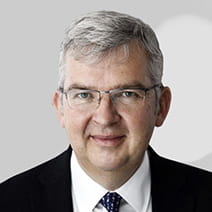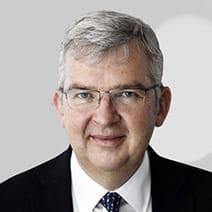- Following a strong start to the year, global markets decline for second consecutive month as central banks warn of higher-for-longer interest rates
- Target exposures to short duration gilts and global government bonds reduced; targets raised for longer duration gilts and corporate bonds
- European and Japanese equities trimmed in highest risk model in favour of US
Global equities and bonds declined for the second month in a row in September as investors recalibrated their expectations for future interest rates on hawkish comments from central banks. The ‘higher for longer’ message had a detrimental impact on equities, but especially on bonds, to which our lower risk funds and portfolios have relatively more exposure.
Global government bonds sold off during September, with 10-year US treasury yields and German bund yields reaching multi-year highs. Markets appear to have finally accepted the ‘higher for longer’ message from central banks on interest rates and investors responded accordingly. Our target exposure to global government bonds is just 1% in our medium to low-risk models and our higher risk models have none, with a more substantial (albeit underweight) exposure to gilts, so the negative impact was limited. In our most recent Tactical Asset Allocation (TAA) review, we reduced our target exposures to short duration gilts and global government bonds in our medium to low-risk models, although we have raised it modestly to longer duration gilts and corporate bonds, where we are seeing attractive opportunities.
We believe gilts now offer the prospect of delivering real yields in the medium term once the inflationary spike abates, while the spreads that investment grade corporate bonds now offer over sovereign bonds mean that quality businesses are trading at good value and offer attractive nominal yields. Funds we use here include iShares UK Gilts All Stocks Index, Royal London Corporate Bond, Fidelity Sustainable MoneyBuilder and AXA Sterling Buy and Maintain Credit.
High yield bond targets remain unchanged however in these models. Our view on high yield remains neutral rather than underweight. Our higher-risk profile solutions have materially less exposure to fixed income.
US rates kept on hold
In our Although the Fed warned about interest rates staying high, it did keep interest rates on hold in September at the 22-year peak of 5.25-5.50%. Investors are split on whether the Fed will raise interest rates again before the end of the year: rising energy costs – oil reached around $96 a barrel in September – have pushed inflation above market expectations, with consumer prices up 3.7% on the year in August versus 3.2% in July. Encouragingly though, US core inflation was down from an annual 4.7% in July to 4.3% in August.1
In our last asset allocation rebalancing, we slightly increased our exposure to US equities in our risk level eight models. Funds we use here include AB American Growth, Artemis US Smaller Companies, Fidelity Index US, JPM US Equity Income and JPM US Small Cap Growth. Our view on the US equity market remains neutral but we are mindful of the strong run a small number of AI-related names have experienced in recent months.
Neutral on European equities
In the eurozone, latest data showed headline inflation was 4.3% in September, its lowest level for two years and down from 5.2% in August.2 However, the European Central Bank still raised its deposit rate to an all-time high by 25 basis points to 4%, marking 10 consecutive rate hikes.3 There were hopes that this would be the last ECB rate hike in the current cycle, but Luis de Guindos, vice president of the ECB, warned that the ‘last mile’ hurdles of bringing inflation back to the 2% target would still be tough to overcome.4
We are neutral on the outlook for European equities but have been trimming our exposure to them in our risk level eight models. Funds we hold that invest in the region include Barings Europe Select, BlackRock European Dynamic, Fidelity Index Europe ex UK, JOHCM Continental European, Jupiter European and Man GLG Continental European Growth.
In the UK, the Bank of England kept the base rate on hold for the first time in two years.5 Inflation continues to fall, with the August headline figure at 6.7% versus 6.8% in July and core inflation at 6.2% from 6.9%.6 Revisions of historical GDP data confirmed that the UK economy has also more than recovered versus its pre-pandemic level.7 From a stock market perspective, we are positive on the outlook for the UK, which has been overlooked by international investors for some years and we do not believe it will require much of a catalyst to release that value.
Japan in balancing act
Japan’s stock market has attracted much attention from investors, having reached a 33-year high this year. It is performing a balancing act between continuing to lift its economy out of decades-long deflation with ultra-loose monetary policy while not letting rising inflation become a major problem. The Bank of Japan maintained its base rate at -0.1% in September.8 A panicked move to normalise monetary policy would spark a spike in Japanese government bond yields but concerns that the BoJ is too far behind the monetary policy tightening curve could also send the yen tumbling lower, exacerbating inflation.9
We continue to monitor Japan closely to see whether its positive run this year is over now, or whether it is still worth going overweight. In the meantime, we have trimmed our exposure to Japanese equities in our highest risk eight level models, where exposure includes Baillie Gifford Japanese, Fidelity Index Japan, M&G Japan Smaller Companies and Man GLG Japan CoreAlpha Professional.
Evergrande restructuring derailed
The saga around China’s real estate sector rumbled on as a scheme to restructure the $300 billion debts of Evergrande, the troubled property group, was delayed pending an investigation into its chairman Hui Ka Yang. Policymakers are under pressure to solve issues raised by the slowdown in the property sector, which accounts for 25% of China’s economy.10
The declines in markets over the last two months show how fickle investor sentiment remains: they continue to be highly sensitive to the latest data or news release and the sell-off across the board sparked by worries over higher-for-longer interest rates illustrates the extent of investors’ uncertainty. Our fundamental views remain the same, however. We are encouraged to see inflation coming down and the Bank of England’s decision to hold rates in September was a welcome positive. The negativity that continues to weigh on market prices could one day be remembered for giving the opportunity to invest for the long term.
1Source: Bureau of Labor Statistics/FT.com 13 September 2023
2Source: FT.com, 29 September 2023
3Source: FT, 14 September 2023
4Source: FT.com, 2 October 2023
5Source: FT.com, 21 September 2023
6Source: FT.com, 20 September 2023
7Source: FT.com, 29 September 2023
8Source: FT.com, 22 September 2023
9Source: FT.com, 2 October 2023
10Source: FT.com, 29 September 2023
KEY RISKS
Past performance is not a guide to future performance. The value of an investment and the income generated from it can fall as well as rise and is not guaranteed. You may get back less than you originally invested.
The issue of units/shares in Liontrust Funds may be subject to an initial charge, which will have an impact on the realisable value of the investment, particularly in the short term. Investments should always be considered as long term.
The Funds and Model Portfolios managed by the Multi-Asset Team may be exposed to the following risks:
Credit Risk: There is a risk that an investment will fail to make required payments and this may reduce the income paid to the fund, or its capital value. The creditworthiness of a bond issuer may also affect that bond's value. Bonds that produce a higher level of income usually also carry greater risk as such bond issuers may have difficulty in paying their debts. The value of a bond would be significantly affected if the issuer either refused to pay or was unable to pay; Counterparty Risk: The insolvency of any institutions providing services such as safekeeping of assets or acting as counterparty to derivatives or other instruments, may expose the Fund to financial loss; Liquidity Risk: If underlying funds suspend or defer the payment of redemption proceeds, the Fund's ability to meet redemption requests may also be affected;Interest Rate Risk: Fluctuations in interest rates may affect the value of the Fund and your investment. Bonds are affected by changes in interest rates and their value and the income they generate can rise or fall as a result; Derivatives Risk: Some of the underlying funds may invest in derivatives, which can, in some circumstances, create wider fluctuations in their prices over time; Emerging Markets: The Fund may invest in less economically developed markets (emerging markets) which can involve greater risks than well developed economies; Currency Risk: The Fund invests in overseas markets and the value of the Fund may fall or rise as a result of changes in exchange rates. Index Tracking Risk: The performance of any passive funds used may not exactly track that of their Indices. Any performance shown in respect of the Model Portfolios are periodically restructured and/or rebalanced. Actual returns may vary from the model returns.
The risks detailed above are reflective of the full range of Funds managed by the Multi-Asset Team and not all of the risks listed are applicable to each individual Fund. For the risks associated with an individual Fund, please refer to its Key Investor Information Document (KIID)/PRIIP KID.
DISCLAIMER
This is a marketing communication. Before making an investment, you should read the relevant Prospectus and the Key Investor Information Document (KIID), which provide full product details including investment charges and risks. These documents can be obtained, free of charge, from www.liontrust.co.uk or direct from Liontrust. Always research your own investments. If you are not a professional investor please consult a regulated financial adviser regarding the suitability of such an investment for you and your personal circumstances.
This should not be construed as advice for investment in any product or security mentioned, an offer to buy or sell units/shares of Funds mentioned, or a solicitation to purchase securities in any company or investment product. Examples of stocks are provided for general information only to demonstrate our investment philosophy. The investment being promoted is for units in a fund, not directly in the underlying assets. It contains information and analysis that is believed to be accurate at the time of publication, but is subject to change without notice. Whilst care has been taken in compiling the content of this document, no representation or warranty, express or implied, is made by Liontrust as to its accuracy or completeness, including for external sources (which may have been used) which have not been verified. It should not be copied, forwarded, reproduced, divulged or otherwise distributed in any form whether by way of fax, email, oral or otherwise, in whole or in part without the express and prior written consent of Liontrust.









